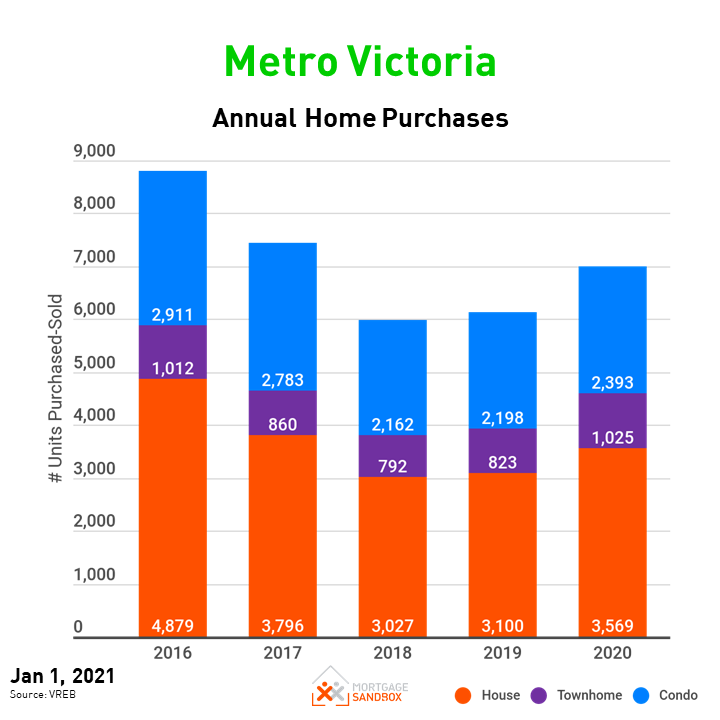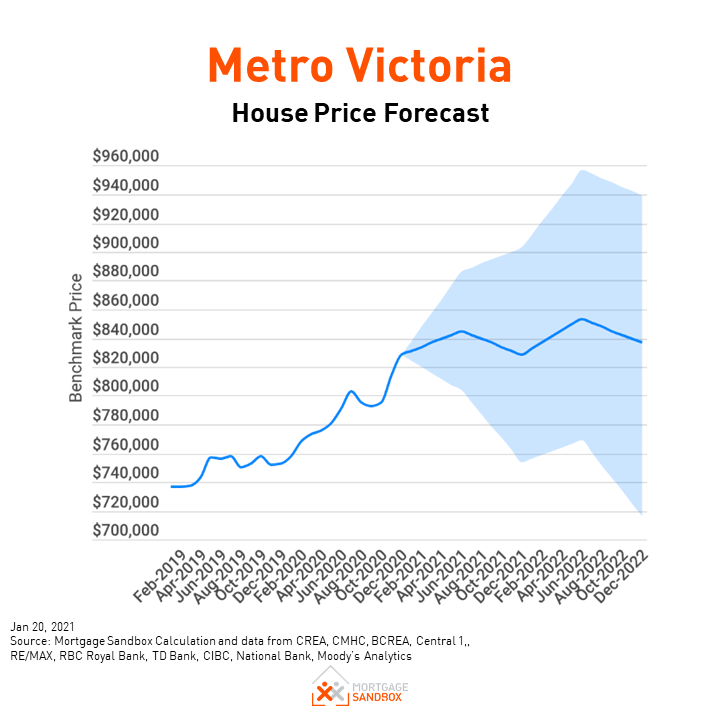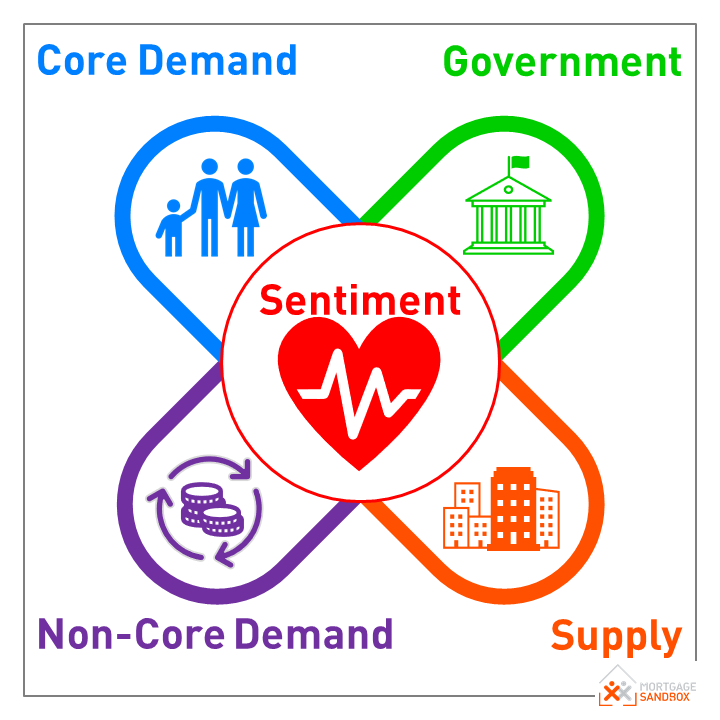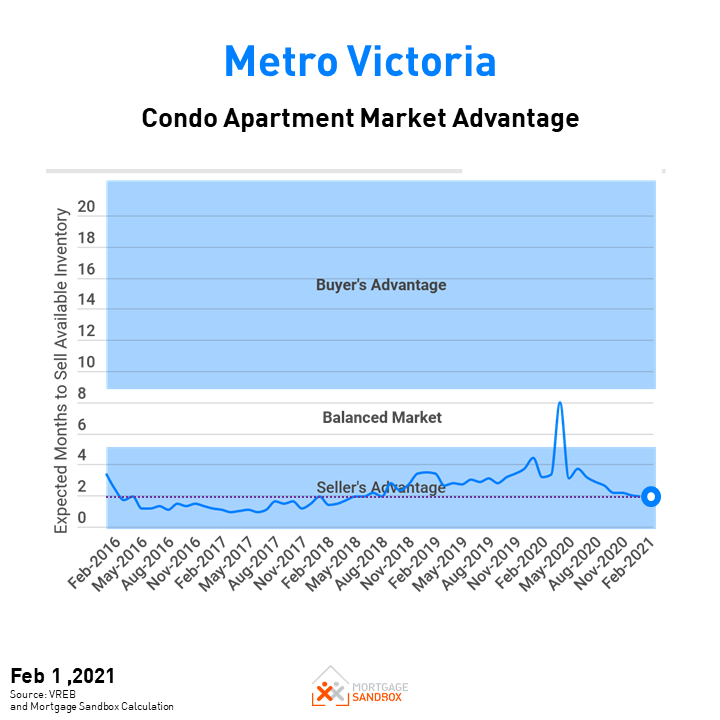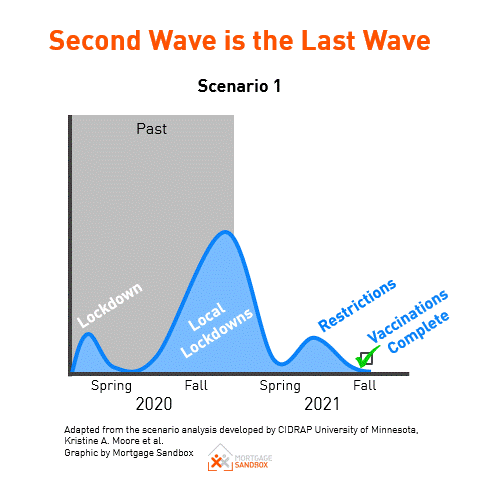Metro Victoria Home Price Forecast - Jan 2021
HIGHLIGHTS
There are now two distinct real estate markets in Metro Victoria. The house market with rising values, and the condo market with not much price appreciation.
Mortgage rates are at historic lows; however, higher unemployment largely offsets the benefits of low rates.
The second wave of COVID-19 is not yet under control. Continued high levels of infection will lead to restrictions and economic fallout.
Vaccines have been approved, but they are unlikely to be widely available until mid-2021. A third wave of infection in Spring 2021 is possible.
This article covers:
Where are Metro Victoria prices headed?
What factors drive the price forecast?
Should investors sell?
Is this a good time to buy?
1. Where are Metro Victoria prices headed?
Home Price Overview
Metro Victoria house prices have accelerated significantly in the past few months, which has pushed more potential home buyers out of the house market. At the same time, condo values have dropped.
This trend can’t continue for long since condos are traditionally the first step on the “property ladder.” If a condo is the primary source of a house buyer’s downpayment, then house prices will eventually be pulled down.
People planning to sell their home will take heart because home values are near all-time highs.
Given the current recession and the second wave of infections, sellers may want to push ahead and sell during the pandemic. With the negative economic impacts still mounting, there is no guarantee that home prices will maintain current values over the next two years. Typically home prices drop during a recession.
The Coronavirus Pandemic, the resulting recession, and the potential for a third wave of infection are now the primary source of uncertainty for home values.
Metro Victoria Detached House Prices
The Victoria benchmark house price is at an all-time high. Government intervention in the market has successfully shielded the real estate market from the pandemic induced recession.
We believe politicians are hoping to guide the market toward a typical annual real estate cycle with price growth in the range of 1 to 3% annually – in line with income growth.
The rising median house price for the Capital Regional District (CRD) indicates shifting buyer preferences. A ‘benchmark’ Victoria house may be a little too small for a family with two parents working from home and children taking online classes.
It seems unlikely that record house prices will be sustained through the next 12 months based on economic fundamentals. So far, buyer sentiment has overwhelmed the core fundamentals.
Market Risk
Overall, according to the CMHC, there is a moderate risk of a price correction in Victoria.
Metro Victoria Condo Prices
Metro Victoria's benchmark apartment price peaked in March. An above-average number of Condos are still being purchased however, the high demand has not translated into higher prices.
With more people working-from-home, we expect developers will begin marketing larger (i.e., 2 and 3 bedrooms) apartments to meet buyer preferences. As the supply of more generous floor plans comes to the market, it may depress the values for small floor plan condos.
At Mortgage Sandbox, we would like developers to build 4 and 5 bedroom condos because:
Not everyone can afford to buy a house for their family.
Canadians who now work from home need more room to segregate workspace from living space within their homes.
Many Canadians with longer working hours find it challenging to stay on top of necessary house upkeep (i.e., mowing lawns, clearing eaves, shovelling sidewalks).
Many people prefer to live in higher-density neighbourhoods with all the essential amenities within walking distance.
Still a challenge for first-time homebuyers
Metro Victoria's home prices are not very affordable. A homebuyer household earning $70,000 (the median Metro Victoria household before-tax income) can only get a $250,000 mortgage. For a homebuyer to purchase a benchmark priced condo, they would need to save hundreds of thousands for a down payment or receive a very generous gift from family. For most people, that is just not possible.
2021 Metro Victoria House Price Forecast
There is a lot of uncertainty in the forecasts for 2021 and 2022. Many of the forecasters we've surveyed have different expectations for:
How likely is the third wave of COVID-19 infections and associated restrictions?
Will the economy will re-open in the 'new normal' in June or December 2021?
Will the federal government succeed in achieving its aggressive immigration targets during a pandemic and with high unemployment?
Since the mortgage payment deferrals expired in October, will the anticipated distressed home sellers appear in the housing market?
As a result of their varying assumptions, some forecasters expect prices to continue rising, while others expect are more likely prices to drop.
For example:
RE/MAX forecasts Victoria's prices will rise 5% in 2021.
The BC Real Estate Association (BCREA) economist, BCREA is a real estate industry advocacy organization, predicts Greater Vancouver prices will rise 5% in 2021 (downgraded from 7% price growth in their previous 2021 forecast).
The highest forecast in a September Reuters poll of 16 economists was price growth of 2% in 2021. The lowest prediction called for a 13% drop.
Moody's Analytics, which develops mortgage risk software for Canadian banks, predicts an 8.5% drop in Victoria. They haven't attempted to pinpoint the timing of the decline in values.
However, our research shows that most past declines in Canadian home values have begun between May and July. Traditionally, there is less supply (fewer listings) between February and May, which puts upward pressure on prices.
CMHC, the government housing agency, predicts a ‘peak-to-trough’ average price drop across Canada of between 9% and 18%.
There is no consensus among economists. Market sentiment and government stimulus have led to price acceleration and record home purchases even though most economic fundamentals have faltered.
We tend to place a little more weight on CMHC and Moody's Analytics. They may be projecting lower values in the future, but:
CMHC sells insurance to banks to help limit their losses if a mortgage goes bad.
Moody’s Analytics sells software to banks to help them assess the risk of their mortgage portfolios.
Both organizations are unique in their ability to see market conditions across the regions and all the banks.
In the next section, we examine the five factors that drive these forecasts. They will help explain why several forecasters are anticipating price drops.
For a more thorough comparison of the Coronavirus Recession to the Great Recession and potential impacts on property prices, check out our recent article: “Should I sell my home today?”
At Mortgage Sandbox, we provide a price range rather than attempting a single prediction because many real estate risks can impact prices. Risks are events that may or may not happen. As a result, we review various forecasts from leading lenders and real estate firms. We then present the most optimistic estimates, the most pessimistic prediction, and the average forecast. Do you want to learn more about real estate risk? We've written a comprehensive report that explains the level of uncertainty in the Canadian real estate market.
Our forecast inputs:
2. What forces drive the price forecast?
Mortgage Sandbox 5 Forces Framework
At the highest level, supply and demand set house prices and all other factors simply drive supply or demand. At Mortgage Sandbox, we have created a five-factor framework for gathering information and performing our market analysis. The five key factors are core demand, non-core demand, government policy, supply, and popular sentiment.
In the long-run, the market is fundamentally driven by economic forces. Still, sentiment can propel prices beyond economically sustainable levels in the short-run.
Below we will summarize how the five factors result in the current Victoria forecast. We also have a report on the five factors driving home prices across British Columbia.
Core Demand
Core demand is a function of:
Population Growth: The pace at which people are moving to an area. An average of roughly 2.5 people live in one household.
Home Price Changes: Changes in the market value of the desired home.
Savings-Equity: How much disposable after-tax income you’ve been able to squirrel away plus any equity you have in your existing home.
Financing: Your maximum mortgage is calculated using income, monthly expenses, and interest rates.
Population Growth
B.C.’s population is almost always growing, but the rate of growth is important for our analysis.
If population growth is the same or lower than in the past, then there is less upward pressure on prices.
At the moment, population growth is lower in B.C. and during the last three months of 2020, the population actually contracted. As a result of ongoing COVID-19 related travel restrictions, we may observe lower growth through to mid-2021.
READ: Fewer People = Less Demand : Easing Population Growth to Weigh on Housing, TD Bank
Home Price Changes
House prices are near all-time records across Metro Victoria. Prices growth reduces affordability and reduces the pool of qualified potential buyers. In an ironic twist, this means rising prices create downward pressure on prices.
As a rule-of-thumb, homeownership costs are considered unaffordable when they exceed 40% of household income.
In March 2020, Victoria's homeownership costs were 58% of the median household income. In other words, Victoria home prices had exceeded economic fundamentals, in a lower interest rate environment, before the impact of the Coronavirus.
However, given that house prices are already extremely unaffordable, the recent price increases will not make homes significantly less affordable.
Savings-Equity
Equity
Existing condo owners seeking to trade-up may benefit from price appreciation until mid-2018, so they have more home equity to use when buying a bigger home.
Anyone who bought more recently benefits less from price appreciation because a benchmark Greater Victoria condo is still valued lower than the value from June 2019. They will still benefit from the equity created by paying down their mortgage.
The recent fall in condo values is eating into the equity available for a move to a townhouse or house.
Savings
Rents were rising faster than incomes, so first-time buyers struggled to come up with down payments.
The stock market dropped because of the pandemic, so anyone who managed to save a down payment and invested it in ‘blue-chip stocks’ may now find out they’ll need to save for a few more months or years.
Financing
Mortgage Rates
The Bank of Canada may reduced rates dramatically, but mortgage qualifying interest rates haven’t fallen nearly as much. Also, lenders have tightened their borrowing guidelines.
Overall, lower rates have not increased home-buying budgets significantly.
Employment and Incomes
Brendan LaCerda, a Senior Economist with Moody’s Analytics, estimates that each 1% rise in unemployment results in a 4% drop in home prices. Until now, the impact of unemployment has been delayed by the CERB and mortgage payment deferral program.
Using this ratio, a prolonged 2.5% rise in Victoria unemployment from 3.4 percent to 5.9 percent would result in a 10% price drop, and a 5% rise in Victoria unemployment to 8.4% would lead to a 20% fall in values.
The ‘official’ B.C. unemployment figures do not include unemployed people who can’t look for work (e.g., people who work in industries that have not fully reopened like tourism or hospitality). The ‘effective’ level of unemployment is higher than the ‘official’ number.
Overall, Victoria’s employment levels are much better than most Canadian cities.
Even after people get re-hired, they will need to be on the job for three months before they qualify for a mortgage pre-approval.
Small businesses and commission salesforce have to show 2 years of consistent income to be eligible for a mortgage. Unless banks change their lending policies, 2020 will drag down their mortgage qualifying income until mid-2023 (when they file their 2022 taxes).
Homeownership Costs
B.C. has seen a meteoric rise in home insurance, which leads to higher monthly strata fees for condo owners.
Property taxes and strata fees are factored into your mortgage affordability calculations, so an increase in strata costs lowers home-buying budgets.
Overall Core Demand
Despite lower interest rates, due to the Coronavirus' impacts, short-term core demand for homes will likely be much lower as we head into 2021.
Non-Core Demand
Non-core demand represents a short-term investment, long-term investment, and recreational demand (i.e., homes not occupied full-time by the owner). Here is where foreign capital, real estate flippers, and dark money come into play. It also includes short-term rentals, long-term rentals, and recreational property purchases.
Since non-core demand is ‘optional’ (i.e., not used to shelter your own family), it is more volatile than core demand.
Foreign Capital
The following factors are likely reducing foreign capital inflows:
The annual B.C. speculation and vacancy tax rate is 2% for foreign owners and satellite families.
Since some foreign buyers were circumventing the tax using Canadian shell companies and straw buyers, the BC government will launch its corporate beneficial ownership registry in May of 2020.
Travel restrictions that are part of Coronavirus containment efforts.
We expect there will be relatively low foreign investment in Canadian real estate until travel restrictions are lifted.
Long-term Rentals
Rental investments are a significant driver of home prices, but now rent rates are falling. Some potential rental investors may hold off on buying until the rental market stabilizes.
Short-term Rentals
International travel restrictions will make many short-term rentals unprofitable for the foreseeable future. Statistics show that, since the travel restrictions were put in place, international travel to Canada has dropped 98 percent.
Fewer investors will be buying real estate for short-term rentals until travel restrictions are lifted.
House Flipping
With rising uncertainty, house flipping has become riskier. We expect many professional flippers will stay away from the market until it stabilizes.
Dark Money
Dark money is the proceeds of crime or money that are transferred to Canada illegally. Dark money includes funds earned legitimately that are transferred illegally from countries with capital controls (e.g., China) and legitimate earnings moved from nations subject to international sanctions (e.g., Iran, Russia, and North Korea).
To hide the illegal nature of the funds, it is laundered in the real estate market. Sometimes, the property's true owner is hidden by using a Straw Buyer, and other times the property is owned by a shell company.
Sometimes a real estate agent or lawyer will accept the illegal cash to help the nefarious individuals hide its origins. In 2015, a B.C. realtor was caught with hundreds of thousands of dollars in her closet at home.
We see no evidence of a diminished role for dark money in local real estate.
Overall Non-Core Demand
The net effect of all the recent changes will reduce capital inflows toward residential real estate for non-core uses, putting downward pressure on Metro Vancouver home prices.
Government Policy
Governments have shielded Canadians and the housing market from the impacts of the pandemic induced recession using:
All of these programs, except for CEWS, have now expired.
Higher Property Taxes
The Federal Government says it will take steps in 2021 to implement a tax on foreign homeowners who live outside of Canada. This is intended to help lower housing prices, but British Columbia's experience shows that foreign ownership taxes and foreign purchaser taxes don’t conclusively lead to lower home values.
Over time, the layering of municipal, provincial, and federal taxes on non-resident owners may impact the market.
Beneficial Ownership Registry
B.C.’s Corporate Beneficial Ownership Registry comes into effect in November of 2020. This may reduce dark money in B.C. real estate and improve collections of foreign buyer taxes.
Overall Government Influence
The government has now unwound many of the programs supporting home values through the recession. Compared to three months ago, there is now much less support from the government to maintain home values.
Supply
Supply comes from two sources.
Existing sales: Existing home sales are sales of ‘used homes.’ They are homes owned by individuals who sell them to upgrade, move for work, or for some other reason. The Victoria Real Estate Board only reports existing home sales and listings.
Pre-Sales and Construction Completions: Most new homes are sold via pre-sales before the construction has started. These are predominantly apartments and townhomes. Data on pre-sales is private and difficult to find, but construction starts (reported by the government) are a very accurate lagging indicator of pre-sale activity.
Rising supply releases the upward pressure on prices caused by demand.
Months of Supply of Existing Homes
House purchases are consistent with past years, while demand for condos is higher. Nevertheless, house prices are rising while condo values have remained flat. The market hasn’t found a new ‘normal’ yet.
Mortgage Delinquencies and Foreclosures
Data indicates that more Canadians are missing their monthly payments, and it appears more Canadians are over-extending themselves. Surprisingly, the increases in delinquencies are led by Ontario and British Columbia, and not Alberta.
According to Equifax, the credit bureau company:
“Mortgage delinquencies have also been on the rise. The 90-day-plus delinquency rate for mortgages rose to 0.18 percent, an increase of 6.7 percent from last year. Ontario (17.6%) led the increases in mortgage delinquency followed by British Columbia (15.6%) and Alberta (14.8%). The most recent rise in mortgage delinquency extends the streak to four straight quarters.”
A recent survey by MNP reported a staggering number of Canadians are stretched to their limits:
“Over 30 per cent of Canadians say they’re concerned that rising interest rates could push them close to bankruptcy, according to a nationwide survey conducted by Ipsos on behalf of MNP, one of the largest personal insolvency practices in the country.”
Although the CMHC can help Canadians via Canadian lenders by refinancing mortgages, it will not help overextended Canadians who chose to finance their homes with private mortgage lenders.
Statistics in May, show that 7 percent of British Columbia mortgage holders applied for mortgage deferrals. Mortgage deferrals expire after 6 months, and that means by October, many of these deferrals will expire. Unless these borrowers have found new work, they will fall into default.
Pre-sales and Completions
New Construction
2020 has kept pace with 2019’s record home completions, and the number of homes under construction is nearly at record levels.
As buildings under construction complete in 2021 and 2022, and people move out of their rental or sell their current home, this new supply should alleviate some of the upward pressure on home values.
Pre-sales
Metro Victoria pre-sales are purchases of unbuilt and completed brand-new homes from developers. Typically, a developer must sell 70% of homes in a building before beginning construction, so housing starts are a good indicator of successful pre-sales.
Pre-sales look sluggish compared to the past two years.
Popular Sentiment
Popular sentiment can be volatile and easily influenced by the latest headlines. Sentiment can shift quickly, as witnessed in the past two years.
Canadian Consumer Confidence
The Ipsos-Reid and Nanos Canadian Confidence Index showed a noticeable drop in 2020 and are now on the mend.
Canadian consumer confidence has improved significantly, buoyed by positive views on real estate. Half of Canadians believe home prices in their neighbourhood will rise over the next six months even though most expect the economy will still be in the dumps.
Although consumer sentiment is a key factor contributing to real estate price trends, consumer sentiment on its own is not an accurate predictor of prices.
Coronavirus Containment
B.C. is struggling to contain the second wave, and we expect localized restrictions and lockdowns. The reimposition of restrictions will likely depress sentiment.
Canada has not yet flattened the curve on wave 2. Several vaccines have been approved, and Prime Minister Trudeau has announced that, if all goes well, most Canadians will be vaccinated by September 2021.
Considering the time between now and September plus the spread of the UK and South African variants, which are more infections, we should probably be preparing ourselves mentally for a third wave of infections before settling into the “new normal.”
The most significant controllable challenges at this stage are:
Anti-maskers - we should be happy to inconvenience ourselves if it means we can avoid the third wave of infection.
Vaccine supplies, shipping logistics, and set-up of enough vaccination sites.
Anti-vaxxers - a quarter of Canadians don't want to take the COVID-19 vaccine.
After initial emergency authorization, the government has prioritized vaccination for front-line health care workers, essential workers, and public safety officials. As well, residents of nursing homes and other Canadians in the highest risk categories.
Vulnerable Canadians will be vaccinated next – more than 25% of Canada’s population (almost 10 million people) is considered at higher risk. Since Canada will be sharing the vaccine with other countries, it will likely take 6 to 9 months to vaccinate vulnerable Canadians and reach the ‘new normal.’
A study headed by Dr. Kristine A. Moore, medical director at the University of Minnesota Center for Infectious Disease Research and Policy, explored scenarios for the pandemic's evolution. Her research team predicted that the second wave in the Fall of 2020 was a likely scenario.
Now that we are in the midst of the second wave, we need to look ahead to what’s next.
Scenario 1 - Second Wave is the Last Wave
Canadians continue to follow health policy guidance and wear masks and continue social distancing until enough people are vaccinated to provide herd immunity. The second wave is the last.
Scenario 2 - Larger Third Wave in 2021
By May 2021, most of the vulnerable have been vaccinated, many Canadians will stop wearing masks and social distancing. They will hold the mistaken belief that vaccinating the most at risk is good enough.
Lax social distancing plus the introduction of more infectious COVID variants lead to the third wave of infections. The lives of many people who are vulnerable, but didn’t know it, would be at risk in this scenario. The provinces would likely have to reimpose local restrictions and lockdowns.
Businesses would have an opportunity to re-open between waves.
Scenario 3 - Extended Second Wave
As a result of the new more infectious variants and restriction non-compliance, we never truly overcome the second wave using social distancing. Instead, it is finally beaten using vaccinated herd immunity.
High case counts over an extended period of time mean that governments will leave restrictions in place for longer.
3. Should Investors Sell?
From a seller’s perspective, more changes in the market that influence prices downward, so now may be a better time to sell than in two years, and the annual real estate cycle usually favours sellers in the first half of the year.
Sellers should always consult a mortgage broker early to prioritize flexible loan conditions and reduce the risk of mortgage cancellation penalties. Find out more about the benefits of a mortgage broker.
Planning to Sell? Check out our Complete Home Seller’s Guide.
4. Is this a good time to buy?
Homebuyers who waited now benefit from lower interest rates and prices that are unchanged from a year ago. They can now get a larger mortgage and buy more house with their larger buying budget.
Coronavirus containment efforts may make it more difficult to visit a bank or view homes. However, if you are considering a purchase, you can get a mortgage pre-approval from a mortgage broker and ask a Realtor to monitor the market, all without leaving your home. Then you’ll be ready when the ‘fog clears.’
Looking forward to 2021, prices are unlikely to rise dramatically, so buyers shouldn’t feel the need to rush to an offer. Also, keep in mind that the seasonal real estate cycle usually favours buyers in late summer.
If you want to buy, be sure to drive a hard bargain and cover your bases with intelligent and educated decisions. Don’t bite off more than you can chew.
Planning to Buy? Check out our Complete Home Buyer’s Guide so we can walk you through the end-to-end process and get you ready to buy your new home!
Here are some recent headlines you might be interested in:
New CMHC report says Canadian housing market could see a 14% plunge (The Star, Jan 21)
These are Canada's fastest growing communities as cities see record exodus (CTV, Jan 19)
Toronto, Montreal see exodus pick up pace, aggravated by COVID-19 pandemic (Globe and Mail, Jan 22)
The stresses that changed Canadian and Ottawa real estate in 2020 (Ottawa Citizen, Jan 2)
Open House: Predicting B.C. real estate trends for 2021 (CBC, Jan 1)
COVID-19 has made reading next year's real estate market harder than ever (CBC. Dec 14)
Interim B.C. money laundering report out, but final inquiry results will be delayed (CTV, Dec 10)
Like this report? Like us on Facebook.


